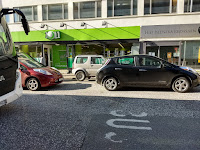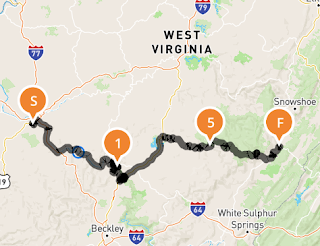Road Trip Planning For Short-Range EVs
Road Trips For Short-Range Electric Vehicles
 |
| A Parade of LEAFs in downtown Reykjavik |
Iceland's 900-mile Ring Road connects most of the inhabitants and tourists along the perimeter of the geologically active island. While electric vehicles (EVs) are not yet available for visiting tourists, the frequency of EV sightings was astounding. The gentle whirr of the Nissan LEAFs Vehicle Sounds for Pedestrians (VSP) was as common as the unmistakable diesel compression combustion sound from passing buses.
 |
| DC quick chargers (orange) along Iceland's Ring Road |
Iceland has very few resources, but in addition to an abundance of sheep, the island nation boasts nearly unlimited geothermal heat that is also the primary source of the island's carbon-free power source. The government even sweetened the deal for EV drivers by blanketing the Ring Road with free DC quick chargers with spacing so that even short-range EVs can circumnavigate the island. Compare that to nearly $8 per gallon of diesel and suddenly the rise of EV popularity makes perfect sense.
If a small resource-limited country like Iceland can do this, what would it take for countries like the US step up the game on charging infrastructure?
If a small resource-limited country like Iceland can do this, what would it take for countries like the US step up the game on charging infrastructure?
Long-Distance Travel, Short-Range EV
 |
| Our EVs - 2015 Tesla Model S and 2016 Nissan LEAF |
Back in the land of Ford F150s, I had a different set of challenges to face than exchanging Icelandic Kronor and watching for sheep crossing the road. Having recently moved from Kansas City, Missouri to West Michigan, we took our Tesla and an ICE minivan (soon to be sold) on the main trip north and left the 2016 Nissan LEAF with friends in Kansas City.
The question now was how to best relocate the 107-mile-range LEAF along the 700-mile trip from KC to Muskegon. The moving company wanted an additional $1,000 for the service. Independent auto movers also quoted prices north of $500. I had also researched a U-Haul auto trailer, but our Toyota Sienna was judged to be inadequate to tow the trailer and its 3,500 pound payload.
The idea to drive the car north began to take shape, but cursory views of the PlugShare map between Missouri and Michigan showed several gaping holes between public charging stations. I could almost picture myself driving to a farmhouse in the middle of a corn field in Iowa asking to plug into a 120V outlet and sleeping in the LEAF while picking up 3 miles of range per hour. This scenario of being stuck without a place to charge is perhaps the reason that many ICE drivers consider that EVs are not ready for prime time.
Having recently read Off The Grid, the tale of two Americans driving their Tesla from Louisiana to Panama, I viewed my cross-country trip in the LEAF as a relative cake walk. Nonetheless, it has the potential to be an adventure.
Proper Prior Planning Prevents Pretty Poor Performance
 |
| Which way should I go? |
Engineers are no strangers to planning, calculations and estimates. In my corporate engineering role world I was a Microsoft Excel jockey, but now recently retired, my tool of choice is Google Sheets. I cobbled together several "what if" scenarios and routes that highlighted charging stations and alternatives.
From Kansas City to West Michigan, you can either go north to Des Moines and east across Iowa towards Chicago before tracing along Lake Michigan or east across Missouri to St. Louis and then northeast through Illinois.
How Much Range Do I Really Have?
A fundamental question arises: what is the longest range that I'm willing to drive without a charge? The EPA estimates that the 2016 LEAF with its 30 kWh battery can go 107 miles on a full charge. But as any EV owner will tell you, there are many factors involved in range. They main factors include battery degradation state, speed, season, and use of auxiliary car features like climate control.
 |
| The LEAF display with Guess-O-Meter on the right |
From a recent LEAF Spy reading, I knew that my battery is just slightly above 90% of its original capacity. I'll be driving in Midwest September, so if I limit my use of the air conditioner and keep my speed down, I should have nearly optimal driving conditions.
The LEAFs range "Guess-O-Meter" is notorious for overestimating range, especially if recent driving conditions warrant it. For example, if you drive around town at low speeds then hop up on the highway, I wouldn't trust the optimistic range it shows as you are accelerating up the on-ramp. To address this issue, some clever individuals assembled these speed vs. range charts for various LEAF models at different states of battery health including my 90% health scenario.
The chart clearly shows the dramatic relationship between speed and energy use. This also means that staying off the highway and driving country roads at, say, 45 MPH should yield significantly more range than keeping up with traffic at 70. Obviously, this would add to the time required for the trip, but not nearly as much as recklessly using more power that requires precious time to charge back into the battery.
Having some background in numerical optimization, I calculated that based on 6.6 KW Level 2 charging, the time optimal speed was fairly flat from 45-55 MPH, but once you get to 60 MPH or above, the total drive and charge time increases significantly because higher speed means dramatically higher wind resistance.
The only way to truly know your car's range is to determine it with a test under normal driving conditions. Charge your car to 100% and drive to nearly empty. Record the distance driven and then charge up with a method that records your power use in kWh. That will allow you to calculate your average miles/kWh.
The only way to truly know your car's range is to determine it with a test under normal driving conditions. Charge your car to 100% and drive to nearly empty. Record the distance driven and then charge up with a method that records your power use in kWh. That will allow you to calculate your average miles/kWh.
PlugShare Trip Planner
 |
| PlugShare Trip Planner screen |
My spreadsheet with driving times, charging locations, and charging times was starting to get busy and convoluted, but I still had not gotten to the point of making a decision whether to make the west-to-east crossing in Iowa or Missouri.
Right on cue, the beta version of the PlugShare Trip Planner was released at the end of July 2018. This clever feature in the web version of PlugShare lets you enter your trip starting point, waypoints, and destination, then search for charging stops along the way.
Note that the screen needs to be a minimum of 1200px wide. This means mobile sized screens are currently not supported.
While it's far from automatic, there are enough features to add stops, allow extra time for charging, show vehicle range, and other routing options to accurately plan your trip. When finished, you can generate an overview, estimate the overall trip time, generate an elevation chart, save your route for later recall or making a separate variant, and export the entire route to Google Maps. I know it's only a beta, but I think it's very slick!
Packing - Be Prepared
Everyone who road trips has their packing list, whether it's in their heads or on paper. Our typical road trips include such items as:
- Water bottles and snacks
- 12V USB phone charger and USB cables
- RAM Mount X-Grip phone holder with 12V USB charger
- Air compressor
- 12V jump starter battery with built-in flashlight
- Toolbox or at least a multi-tool
- Yellow reflective vest
For an EV road trip, consider additional charging accessories like:
 |
| NEMA 14-XX Extension Cord |
- Your mobile "car charger" (officially known as Electric Vehicle Service Equipment or EVSE) - even if it's only a 120V trickle charger, you don't want to be without it.
- 120V extension cord capable of 2 KW in case you can't park close to an outlet.
- Consider an upgraded mobile charger to allow 240V charging like the Amazing-E or the Go Cable. This will allow you to charge at a friend's house with a 240V dryer outlet or even an RV Park 50A circuit. Make sure you have the right adapters!
- Alternately, upgrade your 120V portable charger to handle more power through http://evseupgrade.com/.
- If your home EVSE is not hardwired but simply plugs into an outlet like a NEMA 14-50, bring the whole thing. I've carried around my JuiceBox Pro EVSE on a road trip since I know it will work at RV parks (call ahead to ask if it's OK to charge first).
- NEMA 14-30/14-50 extension cord - if you can't park close to a friend's dryer outlet or an RV outlet, this will save the day. The version I prefer (see picture above) allows the male end to fit into both a NEMA 14-30 and 14-50 receptacle since the bottom flat blade is not used by EV chargers. If plugging into a NEMA 14-30 receptacle, it's important to dial down the power draw to 24 A (80% of the rated circuit capacity) to avoid overheating the circuit or tripping the breaker.
- J-Long J1772 extension cord - if a Level 2 charger is blocked by an ICE vehicle, this lets you park in and adjacent spot and still charge.
 |
| J-Long J1772 Extension Cord |
You can expect to wait while your car charges, so bring something to do or read. I usually carry a ChromeBook computer or and Android tablet to get online at coffee shops as well as a regular book. If you'll be spending time in or around the car while charging, a folding chair, pillow, sleeping bag or blanket will help keep you comfortable.
If there are no restaurants or other services in walking distance, I have also brought a folding bike to allow me to go further than my feet can practically take me.
In the next episode, I will delve into the details of the trip segments I plan to drive from Kansas City to West Michigan. The idea is not so much to get into the weeds too far, but explore the thought process during the planning stage.
Resources
- Previous Episode - Electric Vehicle Road Trips
- PlugShare - already linked in the last episode, but I can't overstate its utility
- LEAF Spy
- Charging adapters, cables, and extensions
- Follow me on Instagram: @muskegonevguy
If you are in the market for a Tesla Model S, Model X, or Model 3 Performance, feel free to use my referral code to get lifetime free Supercharging (before September 16, 2018) or free Supercharging for one year (after September 16, 2018). http://ts.la/karl5062



Comments
Post a Comment
Feedback including suggestions or constructive criticism is welcome. Please note that abusive or offensive comments may be removed.